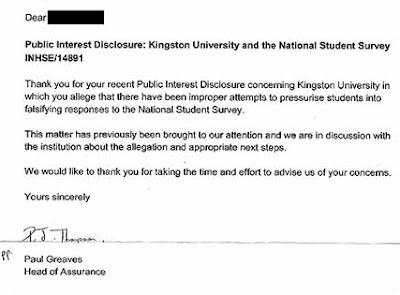 Controversy continues as HEA director leaves post
Controversy continues as HEA director leaves postLee Harvey was on his way to a conference in Amsterdam when he got the call informing him that he had been suspended from his post as director of research and evaluation at the Higher Education Academy. The date was 6 March, the day that a letter he had written describing the National Student Survey as a "hopelessly inadequate improvement tool" was published in Times Higher Education.
Although Professor Harvey signed the letter in a personal capacity, the HEA told him that he may have contravened a clause in his contract barring him from writing to the press without the permission of chief executive Paul Ramsden. Muddying the waters, however, was a previous clash between the two men. After less than a year in post, Professor Harvey had lodged a formal grievance against the HEA chief, which had yet to be resolved at the time of his suspension.
This week, the HEA confirmed that Professor Harvey had left. In a statement, the academy said that it had lifted the suspension and that Professor Harvey had taken the decision to leave "in the best interests of the academy". It added: "As the priority of both the academy and Professor Harvey is to focus all attention on enhancing the student learning experience, neither party will be making any further comment relating to Professor Harvey's employment with, or decision to leave, the HEA."
It is understood that Professor Harvey has signed an agreement barring him from revealing details of the dispute or his subsequent suspension.
The case has raised fundamental questions about both the NSS and the governance and role of the HEA. Professor Harvey's letter was written in response to a Times Higher Education article that reported accusations that London Metropolitan University attempted to manipulate the NSS by instructing staff to tell students that their survey responses would "impact on the reputation of your university ... and your award".
Professor Harvey, who is an internationally renowned expert on student surveys, wrote that it was no surprise that a university was encouraging students to give good ratings, suggesting that it was "just a rather unsubtle form of a widespread practice".
In the two months since his suspension, further reports have lent credence to his assertion. A lecturer at Kingston University was recorded telling students: "If Kingston comes bottom (in the NSS), the bottom line is that no one is going to want to employ you because they'll think your degree is shit."
The story prompted a number of students to recount, via the BBC's website, how they too had been encouraged to boost their universities' results. Universities Secretary John Denham assured Parliament he "utterly condemned" any manipulation of the NSS, and promised to take action if the breaches were proved.
Mr Denham's statement was followed by an announcement from the Higher Education Funding Council for England that tougher guidelines would be issued to universities before the next survey. Whatever academics' views about the merits of the NSS, the case has also raised questions about the role and governance of the HEA.
News of Professor Harvey's suspension provoked an angry response from the academic community, both within the UK and across the world. Times Higher Education received a flood of e-mails, online posts and letters, decrying what many characterised as an attack on academic freedom. Among those expressing their dismay were scholars from as far away as South America, Australia and Africa, while dozens of UK academics also registered their protest via Times Higher Education's website.
Much was made of the personalities involved. A senior academic said the treatment of Professor Harvey, for the offence of saying something that was at worst "not particularly diplomatic", appeared to be entirely disproportionate. "Instead of calling him in and just giving him a telling-off, have they seen this as a way of getting rid of the guy because there's been a relationship breakdown?" he asked.
One HEA insider leaked a document to Times Higher Education that outlined the chief executive's target to "provide effective and empowering leadership". Alongside this, the member of staff wrote: "Not much sign of this, it would seem."
The matter has also prompted questions about HEA's independence and its understanding of the sector it serves. The academy has a remit to be an "authoritative and independent voice on policies that affect the student learning experience" and to "foster robust debate and challenge received wisdom". [Ha!]
Among dozens of comments posted on Times Higher Education's website, the HEA was accused of being a "puppet" and "a tool for Government in pushing through the latest fads", "a bureaucratic superstructure ... unable to understand even basic academic values", as well as a "laughing stock". One academic said the debacle had put the HEA's "reputation and effectiveness" at risk.
One professor of higher education told Times Higher Education: "If he'd been my colleague I would have said, 'Hey Lee, what the hell are you doing? Don't write that'. "But the fact is that he did write it. He wrote it as Lee Harvey from his home address, not from the HEA. Why shouldn't he as an academic be free to express his views? "The HEA is not responsible for the NSS, the Higher Education Funding Council for England is. And my question is, is the HEA independent - or at the very least arm's length - from Hefce? If it isn't, that would really worry me."
As Chris Rust, a senior fellow of the HEA, wrote in a posting to Times Higher Education's website: "This reflects very badly on the HEA and its image as an organisation, and I would suggest that both the academy and Paul Ramsden need all the friends they can get."
From: http://www.timeshighereducation.co.uk




